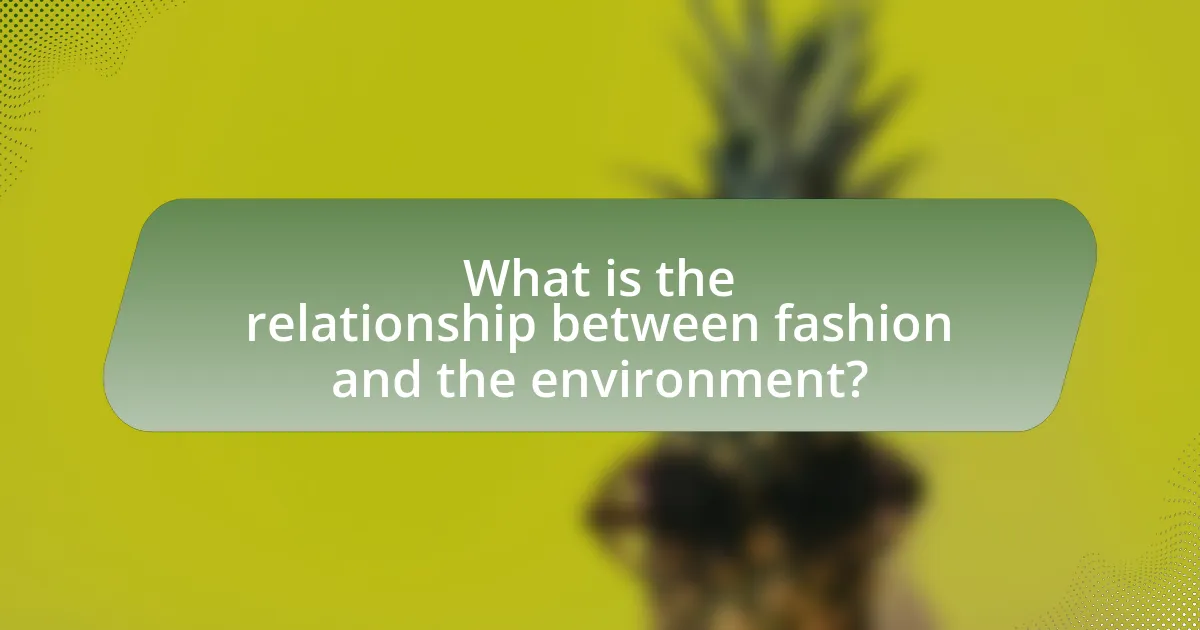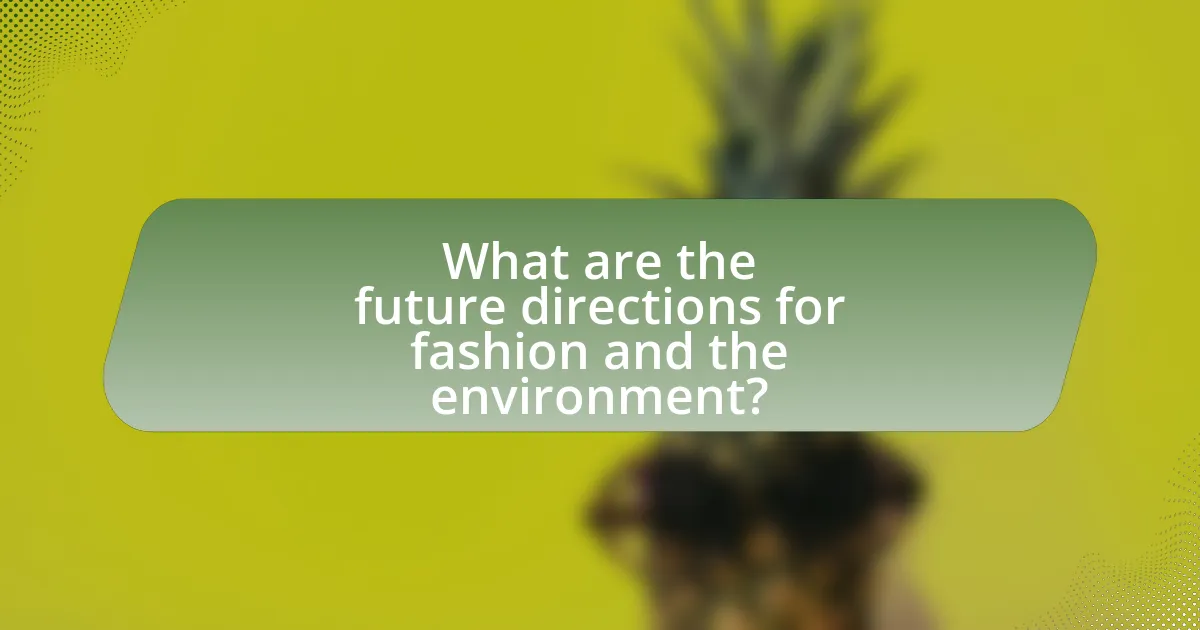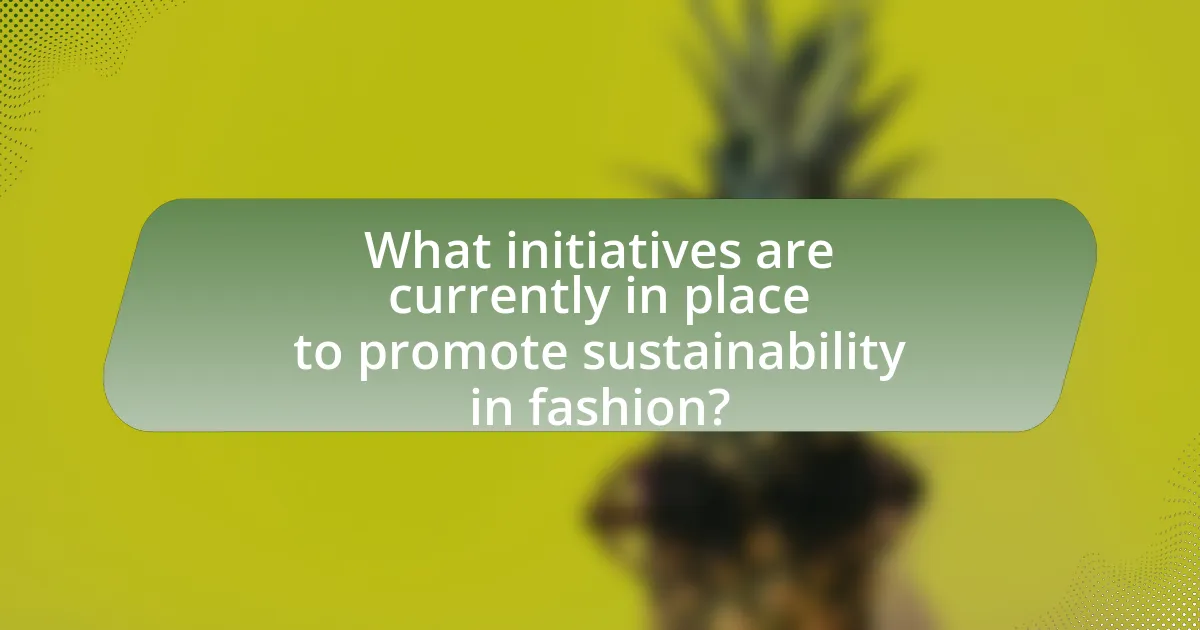The article examines the significant relationship between fashion and the environment, highlighting the fashion industry’s role as a major contributor to environmental degradation through resource depletion, pollution, and waste generation. It discusses historical practices that have exacerbated these issues, such as the rise of fast fashion and the use of synthetic materials, while also addressing current challenges like excessive water consumption and textile waste. The article outlines the importance of sustainable practices, innovative materials, and consumer behavior in shaping the future of fashion, emphasizing the need for accountability and ethical considerations within the industry. Additionally, it explores initiatives and organizations advocating for sustainability, providing practical steps individuals can take to support eco-friendly fashion choices.

What is the relationship between fashion and the environment?
The relationship between fashion and the environment is significant, as the fashion industry is a major contributor to environmental degradation. The production of clothing involves extensive use of water, energy, and chemicals, leading to pollution and resource depletion. For instance, the fashion industry is responsible for approximately 10% of global carbon emissions, according to the United Nations Environment Programme. Additionally, textile waste is a pressing issue, with over 92 million tons generated annually, much of which ends up in landfills. This highlights the urgent need for sustainable practices within the fashion sector to mitigate its environmental impact.
How has fashion historically impacted the environment?
Fashion has historically impacted the environment through resource depletion, pollution, and waste generation. The textile industry, for instance, has been a significant contributor to water pollution, with studies indicating that it is responsible for 20% of global wastewater due to dyeing and finishing processes. Additionally, the production of cotton, a major raw material, requires extensive water usage, with estimates suggesting that it takes about 7,000 liters of water to produce just one kilogram of cotton. Furthermore, the fast fashion model has exacerbated these issues by promoting rapid production cycles, leading to increased textile waste; in 2018, approximately 92 million tons of textile waste were generated globally. These historical practices illustrate the profound environmental consequences of the fashion industry.
What are the key historical practices in fashion that have affected the environment?
Key historical practices in fashion that have affected the environment include the use of synthetic dyes, the rise of fast fashion, and the reliance on non-sustainable materials. Synthetic dyes, introduced in the 19th century, often contain toxic chemicals that pollute water sources. Fast fashion, which emerged in the late 20th century, promotes rapid production cycles and excessive waste, leading to significant environmental degradation. Additionally, the use of non-sustainable materials, such as cotton and polyester, contributes to resource depletion and pollution. For instance, cotton farming consumes large amounts of water and pesticides, while polyester production is linked to fossil fuel extraction and microplastic pollution. These practices collectively highlight the environmental impact of the fashion industry throughout history.
How did industrialization change the environmental footprint of fashion?
Industrialization significantly increased the environmental footprint of fashion by introducing mass production techniques that led to higher resource consumption and waste generation. The shift from handcrafted garments to factory-made clothing resulted in the use of synthetic materials, such as polyester, which are derived from petroleum and contribute to pollution during production and disposal. Additionally, the rise of fast fashion, characterized by rapid production cycles and low-cost garments, has exacerbated water usage and chemical runoff, with the fashion industry now accounting for approximately 20% of global wastewater. This transformation has not only intensified the depletion of natural resources but also increased carbon emissions, with the fashion sector responsible for around 10% of global greenhouse gas emissions.
What are the current environmental challenges faced by the fashion industry?
The current environmental challenges faced by the fashion industry include excessive water consumption, pollution from dyes and chemicals, and significant textile waste. The fashion industry is responsible for using approximately 93 billion cubic meters of water annually, which contributes to water scarcity in many regions. Additionally, the production processes often involve toxic chemicals that contaminate water sources, with an estimated 20% of global wastewater coming from textile dyeing. Furthermore, around 92 million tons of textile waste are generated each year, with a large portion ending up in landfills, exacerbating environmental degradation. These challenges highlight the urgent need for sustainable practices within the industry.
How does fast fashion contribute to environmental degradation?
Fast fashion contributes to environmental degradation primarily through excessive resource consumption and waste generation. The industry is responsible for using approximately 93 billion cubic meters of water annually, which is enough to meet the needs of five million people. Additionally, fast fashion produces around 92 million tons of textile waste each year, much of which ends up in landfills. The production processes often involve harmful chemicals that pollute water sources, and the rapid turnover of clothing encourages a throwaway culture, exacerbating the environmental impact.
What role do materials and production processes play in environmental impact?
Materials and production processes significantly influence environmental impact by determining resource consumption, waste generation, and emissions. For instance, the choice of materials, such as organic cotton versus conventional cotton, affects water usage and pesticide application, with organic cotton using 91% less water and no synthetic pesticides. Additionally, production processes like dyeing and finishing can release toxic chemicals into waterways, contributing to pollution. According to the Ellen MacArthur Foundation, the fashion industry is responsible for 10% of global carbon emissions, highlighting the critical role that both materials and production methods play in shaping environmental outcomes.
What are the social implications of fashion’s environmental impact?
The social implications of fashion’s environmental impact include increased awareness of sustainability, shifts in consumer behavior, and the promotion of ethical labor practices. As the fashion industry contributes significantly to pollution and waste, consumers are becoming more conscious of their purchasing decisions, leading to a demand for eco-friendly products. This shift encourages brands to adopt sustainable practices, which can improve labor conditions and reduce exploitation in developing countries. For instance, the 2021 Fashion Transparency Index reported that 60% of brands are now disclosing their environmental policies, reflecting a growing trend towards accountability and social responsibility in the industry.
How does consumer behavior influence environmental practices in fashion?
Consumer behavior significantly influences environmental practices in fashion by driving demand for sustainable products and practices. As consumers increasingly prioritize eco-friendly options, brands respond by adopting sustainable materials, ethical production methods, and transparent supply chains. For instance, a 2021 survey by McKinsey & Company found that 67% of consumers consider the use of sustainable materials important when making fashion purchases. This shift in consumer preferences compels companies to innovate and implement environmentally responsible practices to remain competitive in the market.
What are the ethical considerations surrounding sustainable fashion?
The ethical considerations surrounding sustainable fashion include labor rights, environmental impact, and consumer responsibility. Labor rights focus on ensuring fair wages and safe working conditions for garment workers, as many fast fashion brands exploit low-cost labor in developing countries. Environmental impact addresses the reduction of waste, pollution, and resource depletion associated with clothing production, with the fashion industry being responsible for approximately 10% of global carbon emissions. Consumer responsibility emphasizes the need for individuals to make informed purchasing decisions that prioritize sustainable practices, such as choosing eco-friendly materials and supporting ethical brands. These considerations highlight the interconnectedness of social justice and environmental stewardship within the sustainable fashion movement.

What are the future directions for fashion and the environment?
Future directions for fashion and the environment include a significant shift towards sustainable practices, such as the adoption of circular economy principles, which aim to minimize waste and maximize resource efficiency. This shift is evidenced by the increasing number of brands committing to sustainable materials, with a report from McKinsey & Company indicating that 67% of fashion executives believe sustainability will be a key driver of growth in the coming years. Additionally, innovations in technology, such as 3D printing and biodegradable fabrics, are expected to play a crucial role in reducing the environmental impact of fashion production. The rise of consumer demand for transparency and ethical practices further supports this trend, as studies show that 73% of millennials are willing to pay more for sustainable products.
How can the fashion industry adopt sustainable practices?
The fashion industry can adopt sustainable practices by implementing circular economy principles, which focus on reducing waste and promoting the reuse and recycling of materials. For instance, brands can design products for longevity, utilize eco-friendly materials, and establish take-back programs to recycle garments. According to a report by the Ellen MacArthur Foundation, transitioning to a circular economy in fashion could reduce greenhouse gas emissions by 44% by 2030. This evidence highlights the potential impact of sustainable practices on environmental preservation within the industry.
What innovative materials are being developed for sustainable fashion?
Innovative materials being developed for sustainable fashion include bio-based textiles, recycled fibers, and lab-grown materials. Bio-based textiles, such as those made from organic cotton, hemp, and Tencel, utilize renewable resources and reduce environmental impact. Recycled fibers, like those derived from post-consumer plastic bottles, significantly decrease waste and resource consumption; for instance, the use of recycled polyester can save up to 60% energy compared to virgin polyester production. Additionally, lab-grown materials, such as mycelium leather and bioengineered fabrics, offer alternatives to traditional animal-based materials, promoting cruelty-free and sustainable practices. These advancements reflect a growing commitment to reducing the fashion industry’s ecological footprint.
How can technology improve sustainability in fashion production?
Technology can improve sustainability in fashion production by enabling more efficient resource management and reducing waste. For instance, advanced data analytics can optimize supply chains, minimizing excess inventory and lowering carbon footprints. Additionally, innovations such as 3D printing allow for on-demand production, which significantly reduces material waste compared to traditional manufacturing methods. According to a report by McKinsey & Company, implementing digital technologies in fashion can lead to a 30% reduction in greenhouse gas emissions by 2030. Furthermore, technologies like blockchain enhance transparency in sourcing, ensuring sustainable practices throughout the supply chain.
What role do consumers play in shaping the future of sustainable fashion?
Consumers play a crucial role in shaping the future of sustainable fashion by driving demand for eco-friendly products and influencing brands to adopt sustainable practices. Their purchasing decisions increasingly favor brands that prioritize sustainability, as evidenced by a 2021 McKinsey report indicating that 67% of consumers consider sustainability when making fashion purchases. This consumer behavior compels companies to innovate and implement sustainable materials, ethical labor practices, and transparent supply chains to meet market expectations. Additionally, consumers actively participate in movements advocating for environmental responsibility, further pressuring brands to align with sustainable values.
How can consumer education promote environmentally friendly fashion choices?
Consumer education can promote environmentally friendly fashion choices by increasing awareness of sustainable practices and the environmental impact of clothing production. Educated consumers are more likely to seek out brands that prioritize eco-friendly materials, ethical labor practices, and sustainable manufacturing processes. For instance, a study by the Ellen MacArthur Foundation found that educating consumers about the environmental costs of fast fashion can lead to a 30% reduction in clothing consumption. This highlights the direct correlation between consumer knowledge and sustainable purchasing behavior, demonstrating that informed choices can significantly reduce the fashion industry’s ecological footprint.
What are the benefits of supporting sustainable fashion brands?
Supporting sustainable fashion brands leads to environmental conservation, social responsibility, and economic benefits. Sustainable fashion reduces waste and pollution by promoting eco-friendly materials and ethical production practices, which can significantly lower the carbon footprint of the fashion industry. For instance, the Ellen MacArthur Foundation reports that the fashion industry is responsible for 10% of global carbon emissions, and sustainable practices can help mitigate this impact. Additionally, supporting these brands fosters fair labor practices, ensuring workers receive fair wages and safe working conditions. This approach not only enhances community well-being but also stimulates local economies. Furthermore, consumers increasingly prefer sustainable options, with a 2021 McKinsey report indicating that 67% of consumers consider sustainability when making a purchase, driving demand for sustainable fashion and encouraging brands to adopt more responsible practices.

What initiatives are currently in place to promote sustainability in fashion?
Currently, initiatives promoting sustainability in fashion include the Fashion Pact, which is a global coalition of companies committed to reducing their environmental impact. This initiative focuses on three key areas: climate, biodiversity, and oceans, aiming to achieve measurable goals such as reducing greenhouse gas emissions by 30% by 2030. Additionally, the Sustainable Apparel Coalition has developed the Higg Index, a tool that enables brands to assess their environmental and social performance, fostering transparency and accountability in the industry. These initiatives are supported by various brands and organizations, reflecting a collective effort to address the environmental challenges posed by the fashion industry.
What are the key organizations and movements advocating for sustainable fashion?
Key organizations and movements advocating for sustainable fashion include the Sustainable Apparel Coalition, Fashion Revolution, and the Ellen MacArthur Foundation. The Sustainable Apparel Coalition focuses on reducing environmental and social impacts in the apparel industry through the Higg Index, a standardized measurement tool. Fashion Revolution promotes transparency and ethical practices in fashion, particularly through its annual Fashion Revolution Week, which raises awareness about the industry’s impact. The Ellen MacArthur Foundation works on circular economy initiatives, encouraging brands to adopt sustainable practices that minimize waste and promote resource efficiency. These organizations collectively drive significant change in the fashion industry towards sustainability.
How do certifications and standards influence sustainable practices in fashion?
Certifications and standards significantly influence sustainable practices in fashion by providing a framework for accountability and transparency. These certifications, such as Global Organic Textile Standard (GOTS) and Fair Trade, set specific criteria that brands must meet regarding environmental impact, labor practices, and resource management. For instance, GOTS requires that at least 70% of the textile must be organic, ensuring reduced chemical use and promoting sustainable farming practices. This not only encourages brands to adopt eco-friendly methods but also informs consumers, enabling them to make informed purchasing decisions. The presence of recognized standards leads to increased competition among brands to improve sustainability, as consumers increasingly favor certified products, thereby driving industry-wide change.
What impact do fashion weeks and events have on sustainability awareness?
Fashion weeks and events significantly enhance sustainability awareness by showcasing eco-friendly practices and promoting sustainable brands. These events serve as platforms for designers to highlight their commitment to environmental responsibility, often featuring collections made from sustainable materials and ethical production methods. For instance, the Copenhagen Fashion Summit, a leading event in the industry, has emphasized sustainability since its inception in 2012, influencing global fashion standards and encouraging brands to adopt sustainable practices. Additionally, the visibility of sustainability-focused initiatives during these events can lead to increased consumer demand for eco-conscious products, as evidenced by a 2021 McKinsey report indicating that 67% of consumers consider sustainability when making fashion purchases.
What practical steps can individuals take to support sustainable fashion?
Individuals can support sustainable fashion by choosing to buy from brands that prioritize ethical production practices and use eco-friendly materials. This choice reduces demand for fast fashion, which is responsible for significant environmental degradation. According to the Ellen MacArthur Foundation, the fashion industry contributes to 10% of global carbon emissions, highlighting the importance of conscious consumerism. Additionally, individuals can extend the life of their clothing by repairing, upcycling, or donating items instead of discarding them, which helps minimize waste. Engaging in clothing swaps or purchasing second-hand items further supports sustainability by reducing the need for new production.
How can consumers make informed choices when purchasing fashion items?
Consumers can make informed choices when purchasing fashion items by researching brands’ sustainability practices and understanding the environmental impact of materials used. For instance, consumers can look for certifications such as Global Organic Textile Standard (GOTS) or Fair Trade, which indicate adherence to environmental and social standards. Additionally, studies show that 66% of consumers are willing to pay more for sustainable brands, highlighting a growing awareness of ethical fashion. By prioritizing transparency and seeking out brands that disclose their supply chain practices, consumers can significantly influence the fashion industry’s environmental footprint.
What are some tips for reducing fashion waste in everyday life?
To reduce fashion waste in everyday life, individuals can adopt practices such as buying second-hand clothing, which extends the lifecycle of garments and reduces demand for new production. Research indicates that the fashion industry is responsible for 10% of global carbon emissions, highlighting the importance of sustainable choices. Additionally, individuals can practice mindful consumption by purchasing only what they need, thereby minimizing excess and waste. Another effective strategy is to repair and upcycle clothing instead of discarding it, which not only reduces waste but also encourages creativity. Finally, donating or recycling unwanted clothes ensures they are reused, further decreasing the environmental impact associated with fashion waste.




